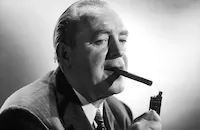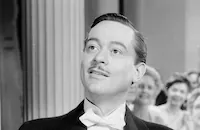Flirtation Walk

Brief Synopsis
Cast & Crew
Frank Borzage
Dick Powell
Ruby Keeler
Pat O'brien
Ross Alexander
John Arledge
Film Details
Technical Specs

Synopsis
Richard Palmer Grant Dorcy, known as "Canary," is an enlisted man in the United States Army. Currently stationed on the Hawaiian Islands, he has an affectionately argumentative relationship with his sergeant, Scrapper Thornhill. Although he hates taking orders, Dick has no intention of becoming an officer. When General Fitts arrives at the base with his daughter Kit, Dick is assigned to drive her to the reception that evening. Falling victim to the moonlit night, Kit and Dick miss the reception and attend a native luau instead. They are discovered in each other's arms by Lieutenant Biddle, who is also in love with Kit. Biddle blames Dick for ruining Kit's reputation and Dick decides to desert. Scrapper begs Kit to straighten things out with Biddle. To prevent Dick from deserting, Kit tells him that she is not in love with him, but was responding to a crazy impulse. Stung by her words, Dick decides to compete with Biddle as an equal and applies for West Point. He is accepted and does very well, to Scrapper's delight. In Dick's senior year, General Fitts is appointed West Point superintendent. While most of the men are infatuated with Kit, Dick is cold to her. Consequently, he is not very happy when the rest of the men insist that she participate in the traditional Hundredth Night theatrical performance. Dick writes a show about a female general with a message directed at Kit. After the first rehearsal, Kit walks with Dick on Flirtation Walk and tries to explain why she told him she was not in love with him. Dick is too angry to listen to Kit but, during their on-stage love scene, kisses her, and she admits she loves him. When General Fitts announces Kit's engagement to Biddle, Dick naturally is confused, and visits her after lights out to talk her out of marrying Biddle. He is caught and, to protect Kit's name, agrees to resign from the Academy. Scrapper arrives at the Academy to see Dick graduate and is disappointed to learn of Dick's resignation. The day is saved when Biddle tells Dick that his resignation was not accepted and that Kit returned his ring. Dick graduates a happy man.

Director

Frank Borzage
Cast

Dick Powell

Ruby Keeler

Pat O'brien

Ross Alexander

John Arledge

John Eldredge

Henry O'neill

Guinn Williams
Frederick Burton
John Darrow
Glen Boles
Cliff Saum

Paul Fix
Sol Bright
Col. Timothy J. Lonergan
William Worthington

Emmett Vogan
Maude Turner Gordon
Frank Dawson
Frances Lee
Avis Johnson
Carlyle Blackwell Jr.
Dick Winslow
Mary Russell
Barbara Leonard
Crew
George Barnes
Frank Borzage
Lew Borzage
Paul Burnett
Bobby Connelly
Delmer Daves
Delmer Daves
Mort Dixon
Lieut. M. P. Echols
Lou Edelman
Leo F. Forbstein
Al Green
Oren Haglund
William Holmes
Mac Julian
Col. Timothy J. Lonergan
Robert Lord
L. P. "dudie" Mashmeyer
Jack Okey
Orry-kelly
William Phelan
Sol Polito
C. A. Riggs
Allie Wrubel

Videos
Movie Clip



Trailer
Hosted Intro
Film Details
Technical Specs

Award Nominations
Best Picture
Best Sound
Articles
Flirtation Walk
Powell stars as Dick Dorcy, a wiseacre army private stationed in Hawaii, who one day violates protocol by spending a moonlit night with Kit Fitts (Keeler), a general's daughter. Later insulted by Kit's smug fiancé, Lieutenant Robert Biddle (John Eldredge), Dick decides to one-up his rival by applying to West Point to become "an officer and a gentleman." There, his path again crosses with Kit's, and instead of toeing the "long gray line," he chooses to walk arm-in-arm with her down Flirtation Walk, a legendary wooded promenade for the love-stricken cadet. When the threat of scandal again intrudes upon the would-be lovers, Dick must choose between abandoning his military career or possibly spoiling the reputation of his beloved Kit.
Although the setting was far from Broadway, the producers of Flirtation Walk couldn't resist adding a few dashes of musical spectacle to the military romance, often in unconventional forms. In one scene, Dick and Kit stumble upon an epic luau in which dozens of Hawaiians harmonize and sway beneath the lovers' moon. In a more peculiar twist on the Busby Berkeley aesthetic, several lengthy scenes are devoted to the West Point cadets marching in formation as they pass in review, their tightly choreographed marches backed by a military band instead of a jazzy orchestra.
The thought of putting Powell and Keeler together in a film and not letting them sing was, of course, unthinkable. A subplot was therefore introduced in which Dick, aptly nicknamed "Canary," stages a variety show prior to the cadets' graduation. It is there that the stars finally share a duet and the distinctive peppy, brassy sound of the Warner Bros. orchestra (under the direction of Leo F. Forbstein) is at last unleashed. While Flirtation Walk continues to charm, almost 70 years later, Dick's musical farce within the film has not aged quite as gracefully, based on the "absurd" premise that a woman is promoted to general and put in charge of the Academy. Keeler's playful performance as the silk-uniformed general makes the mini-musical charming all the same, even without exercising her talents as a dancer.
Of the songs written by Allie Wrubel and Mort Dixon, the climactic "Mr. and Mrs. Is the Name" is the standout number, capturing some of the zest of the best 1930s Warner musicals. The studio was later confronted by a songwriter named Irving Gielow, who demanded $550,000 from the producer, claiming two of his songs had been plagiarized in the film. However, studio mogul Jack Warner took pleasure in squaring off with the overly litigious Mr. Gielow who was soon sent on his way, empty-handed.
To add some weight to the breezy Powell/Keeler romance, the cast was expanded to include the personification of Depression-era happy-go-lucky manliness: Pat O'Brien. As Dick's stern but protective sergeant, O'Brien (The Front Page (1931), Ceiling Zero, 1935) provides the necessary element of rough-and-tumble camaraderie that lent the film some military authenticity, while securing the interest of the typically musical-phobic male audience. Yet even O'Brien seems charmed by the effervescent romance between Dick and Kit, and the gruff character actor sheds a few tears in the film's final reel -- a stunning departure for the shouting, punching, tough-talking O'Brien.
One of the standout supporting actors is the young comedian Ross Alexander, who portrays Dick's West Point sidekick "Oskie". Regrettably, Alexander never clicked with moviegoers and was soon banished to third-rate pictures, before committing suicide in 1937 at age 30.
The deft blend of comedy, music and drama in Flirtation Walk earned the film an Academy Award nomination, though Frank Capra's It Happened One Night claimed the prized statuette. Encouraged by the success of the film, Powell, Keeler and Ross Alexander re-teamed with director Borzage the following year to make another military-themed romance, Shipmates Forever (1935). Borzage is best known for a series of dreamy romances made at Fox Studios near the end of the silent era. Although he continued working until 1959, creating such sound era classics as A Farewell to Arms (1932) and History Is Made at Night (1937), few of his later works captured the ethereal sensuality of such silent movies as Seventh Heaven (1927), Street Angel (1928) or Lucky Star (1929), all starring Janet Gaynor.
In 1950, Flirtation Walk was remade, with a host of alterations, as The West Point Story. Coincidentally, the star of this updated version was James Cagney, another Warner Bros. star who had appeared alongside Powell and Keeler in their 1933 hit Footlight Parade.
Producer/Director: Frank Borzage
Screenplay: Delmer Daves
Based on a story by Lou Edelman and Delmer Daves
Cinematography: Sol Polito and George Barnes
Production Design: Jack Okey
Songs by Allie Wrubel and Mort Dixon
Musical Director: Leo F. Forbstein
Choreography: Bobby Connolly
Cast: Dick Powell (Dick Dorcy), Ruby Keeler (Kit Fitts), Pat O'Brien (Sgt. "Scrapper" Thornhill), Ross Alexander ("Oskie"), John Eldredge (Lt. Robert Biddle), Henry O'Neill (Gen. Jack Fitts).
BW-98m.
By Felicia Feaster

Flirtation Walk
Quotes
Trivia
Bobby Connolly shot the Hawaiian number on the biggest set ever constructed at Warner Bros. studio up until that time. He followed with the military wedding number using 400 professional dancers.
Notes
According to an onscreen prologue, the film is dedicated to the United States Military Academy, West Point. The New York Times review reports that many of the scenes were actually shot at West Point. An news item in Daily Variety notes that Barbara Leonard replaced Maxine Doyle, who was working in M-G-M's film Student Tour. According to news items in Hollywood Reporter, Bobby Connolly started shooting the Hawaiian number on July 3, 1934 on the biggest set ever constructed at Warner Bros. studios. He was scheduled to finish on 10 Jul, at which time he would start the military wedding number using over 400 professional dancers. The film received Academy Award nominations for Best Picture and Best Sound Recording. Modern sources add the following credits: Assistant Director Bill Cannon; Assistant Camera Frank Evans; Recording Engineer E. A. Brown; and add to the cast, Lt. Joe Cummins, Gertrude Keeler, Tyrone Power, Madeline Borzage and Sol Hoopii and his Hawaiian Band.
















